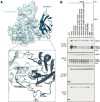Distinct accessory roles of Arabidopsis VEL proteins in Polycomb silencing
- PMID: 37734835
- PMCID: PMC7615239
- DOI: 10.1101/gad.350814.123
Distinct accessory roles of Arabidopsis VEL proteins in Polycomb silencing
Abstract
Polycomb repressive complex 2 (PRC2) mediates epigenetic silencing of target genes in animals and plants. In Arabidopsis, PRC2 is required for the cold-induced epigenetic silencing of the FLC floral repressor locus to align flowering with spring. During this process, PRC2 relies on VEL accessory factors, including the constitutively expressed VRN5 and the cold-induced VIN3. The VEL proteins are physically associated with PRC2, but their individual functions remain unclear. Here, we show an intimate association between recombinant VRN5 and multiple components within a reconstituted PRC2, dependent on a compact conformation of VRN5 central domains. Key residues mediating this compact conformation are conserved among VRN5 orthologs across the plant kingdom. In contrast, VIN3 interacts with VAL1, a transcriptional repressor that binds directly to FLC These associations differentially affect their role in H3K27me deposition: Both proteins are required for H3K27me3, but only VRN5 is necessary for H3K27me2. Although originally defined as vernalization regulators, VIN3 and VRN5 coassociate with many targets in the Arabidopsis genome that are modified with H3K27me3. Our work therefore reveals the distinct accessory roles for VEL proteins in conferring cold-induced silencing on FLC, with broad relevance for PRC2 targets generally.
Keywords: PRC2; Polycomb silencing; VAL1; VIN3; VRN5; vernalization.
© 2023 Franco-Echevarría et al.; Published by Cold Spring Harbor Laboratory Press.
Figures







Similar articles
-
VEL-dependent polymerization maintains the chromatin association of Polycomb proteins for the switch to epigenetic silencing.Mol Cell. 2025 Sep 4;85(17):3321-3332.e5. doi: 10.1016/j.molcel.2025.08.002. Epub 2025 Aug 25. Mol Cell. 2025. PMID: 40858112
-
A PHD-polycomb repressive complex 2 triggers the epigenetic silencing of FLC during vernalization.Proc Natl Acad Sci U S A. 2008 Nov 4;105(44):16831-6. doi: 10.1073/pnas.0808687105. Epub 2008 Oct 14. Proc Natl Acad Sci U S A. 2008. PMID: 18854416 Free PMC article.
-
Arabidopsis transcriptional repressor VAL1 triggers Polycomb silencing at FLC during vernalization.Science. 2016 Jul 29;353(6298):485-8. doi: 10.1126/science.aaf7354. Science. 2016. PMID: 27471304
-
Storing memories: the distinct phases of Polycomb-mediated silencing of Arabidopsis FLC.Biochem Soc Trans. 2019 Aug 30;47(4):1187-1196. doi: 10.1042/BST20190255. Epub 2019 Jul 5. Biochem Soc Trans. 2019. PMID: 31278155 Review.
-
Vernalization-mediated chromatin changes.J Exp Bot. 2012 Jul;63(12):4343-8. doi: 10.1093/jxb/ers157. Epub 2012 Jun 8. J Exp Bot. 2012. PMID: 22685309 Review.
Cited by
-
Epigenetics in the modern era of crop improvements.Sci China Life Sci. 2025 Jun;68(6):1570-1609. doi: 10.1007/s11427-024-2784-3. Epub 2025 Jan 8. Sci China Life Sci. 2025. PMID: 39808224 Review.
-
Flowering time: From physiology, through genetics to mechanism.Plant Physiol. 2024 Apr 30;195(1):190-212. doi: 10.1093/plphys/kiae109. Plant Physiol. 2024. PMID: 38417841 Free PMC article. Review.
-
Cold-induced nucleosome dynamics linked to silencing of Arabidopsis FLC.Nat Commun. 2025 Jul 1;16(1):5550. doi: 10.1038/s41467-025-60735-z. Nat Commun. 2025. PMID: 40593581 Free PMC article.
-
Targets and mechanisms of epigenetic regulation in the temperate cereal vernalisation process.Front Plant Sci. 2025 Aug 5;16:1520593. doi: 10.3389/fpls.2025.1520593. eCollection 2025. Front Plant Sci. 2025. PMID: 40838075 Free PMC article. Review.
-
COOLAIR and PRC2 function in parallel to silence FLC during vernalization.Proc Natl Acad Sci U S A. 2024 Jan 23;121(4):e2311474121. doi: 10.1073/pnas.2311474121. Epub 2024 Jan 18. Proc Natl Acad Sci U S A. 2024. PMID: 38236739 Free PMC article.
References
Publication types
MeSH terms
Substances
Grants and funding
- MC_U105192713/MRC_/Medical Research Council/United Kingdom
- 210654/WT_/Wellcome Trust/United Kingdom
- 210654/Z/18/Z/WT_/Wellcome Trust/United Kingdom
- BB/J004588/1/BB_/Biotechnology and Biological Sciences Research Council/United Kingdom
- BB/P013511/1/BB_/Biotechnology and Biological Sciences Research Council/United Kingdom
LinkOut - more resources
Full Text Sources
